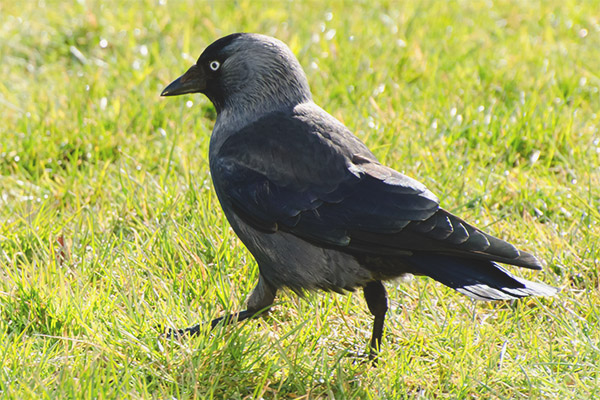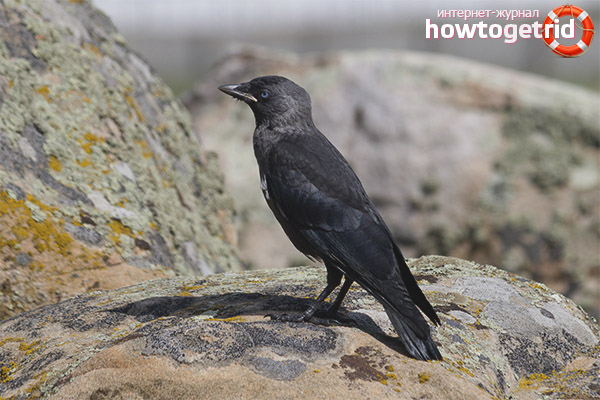The content of the article
The galka bird lives in the western part of Eurasia, as well as in the northern regions of the African continent. They usually live in cities and towns where there is an open area nearby, such as a meadow or a field. People have long been interested in this interesting bird. A person is attracted by the tendency of these birds to settle near people. Special love for everything brilliant is inherent in these individuals. In addition, these birds are sociable and can be easily tamed.
Description
This bird is smaller than a crow. Addition is rather dense. At length it reaches 33-38 cm, the bird weighs only 140-270 g, its wingspan is 66-73 cm. If you look at these birds from afar, it seems that they are completely black. For this reason they are often mistaken for a raven. Their beak is rather short, black. The tail is round, has an average length. When the bird is excited, a small crest rises on its nape.
On the head, on the back, and on their chest, the plumage has a gray color. On the cheeks and the back of the head visible bright spots of silver hue. Their tail and wings are black. Plumage casts purple or blue.
The older males become, the less plumage they have on their heads. Basically, the jackdaws of both sexes look the same. Juveniles are duller in color.
Nutrition
In summer, invertebrates are hunted. They like to eat various beetles, as well as grasshoppers, mollusks, spiders, worms. Sometimes rodents and even bats can become their victims. Jackdaws can hunt live animals or pick up the dead. But carrion is extremely rare. Sometimes it eats chicks or eggs of other birds.
From plant foods eat berries, pea seeds or wheat. Often they eat food waste thrown away by humans. They hunt or look for seeds in open areas, sometimes in a tree. She can dig her beak in the ground or dung.Sometimes looking for insects in livestock wool that grazes in the meadows. In cities and villages, these birds feed in squares and gardens, near garbage cans and in vegetable gardens.
Habitat
This bird lives throughout Europe, ranging from the Atlantic Ocean and the mountains located in the northwestern part of the African continent. Further, the range extends to the Yenisei and Altai. On the territory of Europe live everywhere. You can not meet them only in Finland and in the Scandinavian Peninsula. Favorite habitats in nature are the rocky coasts of the seas and the high banks of rivers, mountains. They do not settle only in swampy areas or too open territories. The rest of the landscape types are quite suitable for this bird.
Most of the representatives of this species can be found in small towns and villages, near which there is an open area.
It is known that already in the 12th century, these birds settled in cities. Today, these birds inhabit more populated areas than in the wild. They choose old buildings, towers and other buildings to settle in them. In order for the jackdaw to build a nest, any open space will do.In the city they easily find food.
Populations in the north and east of the range are migratory. The rest can wander in search of food.
Kinds
- Alpine. The length of the body is 36-38 cm, the wingspan is 74-84 cm, they weigh 190-250 g. Their plumage is black and shiny, and their legs are painted red. Bill is yellow, shortish. The wings of the alpine daws are narrow. Males of this species are somewhat larger than females. Juveniles are also black, but their plumage does not shine. Their bill is yellowish in color, and their legs are brown. Alpine daws live in Morocco, as well as from the Iberian Peninsula to China itself. They prefer to settle in the mountains.
- Daur. The length of the body of these birds is 31-33 cm. According to external characteristics it is very similar to the European one, but these two species differ in coloring features. Those parts that are colored gray in European representatives and white in Dahurian ones. They live in eastern Asia (this is east of Russia, as well as Korea and China). He lives in the hills in the mountains. As well as river valleys. You can also meet the Dahurian daw in the open forest.
Breeding
Jackdaws become sexually mature at 2 years. They belong to monogamous birds and can find a partner for themselves before the onset of puberty. Often a pair is formed when the birds are not even a year old. Sometimes couples break up at first, and then the birds stay together for life.
A pair of these birds may nest separately from other individuals or 20-30 pairs each. They can build a nest close to other representatives of birds, for example, rooks or pigeons. The beginning of the nesting period depends on the weather. If spring comes earlier, then these birds can begin laying in early April. If the spring is cold, they postpone until May.
Jacks for jackdaws often serve as a natural or artificially created niche. This could be, for example, a crack in a rock, a hollow, or the attic of an abandoned house. Sometimes jackdaws just occupy the nest of another bird left from last year, which was abandoned. Both female and male build the nest. It consists of twigs, grass and horse manure. They make a pile of wool or feathers, sometimes they line the nest with rags found in landfills or paper.
Lay 3-8 eggs at a time. Most often they are 4.5 or 6.If, for any reason, the clutch dies, the female will lay eggs again. Eggs have a light turquoise tinge in small speck. Hatching lasts about 20 days. The female is sitting on eggs, and the partner at this time provides her with food. Nestlings hatch blind. On the body they have a gray down. Every parent brings them food. When they reach the age of one month, they leave the nest. 7 days after that they fly independently. Parents bring them food for another month.
These birds live about 14 years.
Vote
They are very noisy. They produce sharp strong sounds that can be described as “kai”. This sound they repeat up to 8 times.
Interesting Facts
- The Russian name of this bird comes from the Old Slavonic word, which can be translated into modern language as “black”. This word is sometimes called not only the representatives of the species, but also the birds, which are similar in appearance to them. These are crows or black chickens. Previously, this word was called people with black hair. It is believed that the name is an imitation of the voice of the bird.
- The Latin name for the species “monedula” most likely comes from two words: “monedula”, which means coin or money, and also “edo”, which can be translated as “I eat”. Ovid mentions the bird in his "Metamorphoses".It tells about a Greek princess who betrayed her country for money. Because of this, the princess was turned into a bird who loves shiny things very much.
- In nature, there are many birds of this species. The number cannot be precisely named, but it is believed that there are between 20 and 90 million. Most of the population lives in Eurasia.
Video: daw (Corvus monedula)













To send